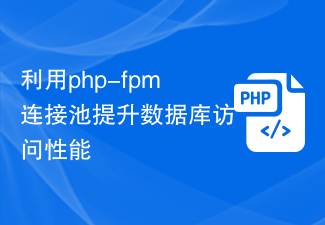How to reasonably adjust the php-fpm process pool configuration
When using PHP to develop web applications, PHP-FPM (PHP FastCGI Process Manager) is a very important component. It is responsible for handling PHP requests from the web server and managing the PHP process pool. Properly configuring the php-fpm process pool can improve the performance and stability of web applications. This article will introduce how to properly adjust the php-fpm process pool configuration and provide some code examples.
- Understanding the php-fpm process pool
First, let us understand the concept of the php-fpm process pool. php-fpm handles PHP requests through a process pool, and each process can handle one request. The process pool has the following important parameters:
- pm.max_children: The maximum number of processes allowed in the process pool.
- pm.start_servers: The initial number of processes in the process pool at startup.
- pm.min_spare_servers: The minimum number of idle processes in the process pool.
- pm.max_spare_servers: The maximum number of idle processes in the process pool.
- Adjust pm.max_children
pm.max_children is the maximum number of processes allowed in the process pool. This value usually needs to be adjusted based on server configuration and application load. If the setting is too small, concurrent requests may not be satisfied; if the setting is too large, server resources may be exhausted.
The following is an example configuration, here setting pm.max_children to 100:
pm.max_children = 100
- Adjust pm.start_servers and pm.min_spare_servers
pm. start_servers is the initial number of processes in the process pool at startup, and pm.min_spare_servers is the minimum number of idle processes in the process pool. These two parameters determine how many idle processes php-fpm should have at startup and when load is low.
The following is an example configuration, setting both pm.start_servers and pm.min_spare_servers to 20:
pm.start_servers = 20 pm.min_spare_servers = 20
- Adjust pm.max_spare_servers
pm. max_spare_servers is the maximum number of idle processes in the process pool. When the load is light, php-fpm will try to maintain a pm.max_spare_servers number of idle processes. The larger this value, the more idle processes the system will keep in order to respond more quickly to increases in load.
The following is an example configuration, setting pm.max_spare_servers to 50:
pm.max_spare_servers = 50
- Other configuration parameters
In addition to the above parameters, there are Some other configuration parameters also need attention, such as:
- pm.max_requests: The maximum number of requests handled by each PHP process. Once this value is reached, php-fpm will restart the process.
- pm.process_idle_timeout: The maximum survival time of an idle process. After this time is reached, php-fpm will shut down the process.
According to actual needs, these parameters can be adjusted to improve performance and stability.
The following is a sample configuration, setting pm.max_requests to 1000 and pm.process_idle_timeout to 10 minutes:
pm.max_requests = 1000 pm.process_idle_timeout = 10m
Summary
Reasonably adjust the php-fpm process pool Configuration can improve the performance and stability of web applications. By understanding the parameters of the process pool and adjusting them according to the server configuration and application load, you can optimize the operation of php-fpm. In actual applications, adjusting the process pool configuration may require multiple experiments and adjustments based on different environments and needs to find the best configuration.
Reference code examples have been provided in this article, hoping to help readers better understand how to reasonably adjust the php-fpm process pool configuration. At the same time, it is also recommended that readers reconfirm the current server configuration and application load before using the code to avoid unnecessary problems caused by misconfiguration.
The above is the detailed content of How to reasonably adjust the php-fpm process pool configuration. For more information, please follow other related articles on the PHP Chinese website!
 如何使用php-fpm进行高性能调优Jul 08, 2023 am 11:30 AM
如何使用php-fpm进行高性能调优Jul 08, 2023 am 11:30 AM如何使用php-fpm进行高性能调优PHP是一种非常流行的服务器端脚本语言,广泛用于开发网页应用和动态网站。然而,随着访问量的增加,PHP应用程序的性能可能会受到影响。为了解决这个问题,我们可以使用php-fpm(FastCGIProcessManager)来进行高性能调优。本文将介绍如何使用php-fpm来提升PHP应用程序的性能,并提供代码示例。一、
 如何使用PHP-FPM优化提高WooCommerce应用的性能Oct 05, 2023 am 08:24 AM
如何使用PHP-FPM优化提高WooCommerce应用的性能Oct 05, 2023 am 08:24 AM如何使用PHP-FPM优化提高WooCommerce应用的性能概述WooCommerce是一个非常流行的电子商务插件,用于在WordPress网站上创建和管理在线商店。然而,随着商店的增长和流量的增加,WooCommerce应用可能会变得缓慢和不稳定。为了解决这个问题,我们可以使用PHP-FPM来优化和提高WooCommerce应用的性能。什么是PHP-FP
 利用php-fpm连接池提升数据库访问性能Jul 07, 2023 am 09:24 AM
利用php-fpm连接池提升数据库访问性能Jul 07, 2023 am 09:24 AM利用php-fpm连接池提升数据库访问性能概述:在Web开发中,数据库的访问是非常频繁且耗时的操作之一。传统的方法是每次数据库操作都新建一个数据库连接,使用完毕后再关闭连接。这种方式会造成数据库连接的频繁建立和关闭,增加了系统的开销。为了解决这个问题,可以利用php-fpm连接池技术来提升数据库访问性能。连接池的原理:连接池是一种缓存技术,将一定数量的数据库
 php-fpm调优方法详解Jul 08, 2023 pm 04:31 PM
php-fpm调优方法详解Jul 08, 2023 pm 04:31 PMPHP-FPM是一种常用的PHP进程管理器,用于提供更好的PHP性能和稳定性。然而,在高负载环境下,PHP-FPM的默认配置可能无法满足需求,因此我们需要对其进行调优。本文将详细介绍PHP-FPM的调优方法,并给出一些代码示例。一、增加进程数默认情况下,PHP-FPM只启动少量的进程来处理请求。在高负载环境下,我们可以通过增加进程数来提高PHP-FPM的并发
 什么是php-fpm?如何进行优化来提升性能?May 13, 2022 pm 07:56 PM
什么是php-fpm?如何进行优化来提升性能?May 13, 2022 pm 07:56 PM什么是php-fpm?下面本篇带大家了解一下php-fpm,介绍一下优化 php-fpm 时我们到底要优化什么,希望对大家有所帮助!
 ubuntu没有php-fpm怎么办Feb 03, 2023 am 10:51 AM
ubuntu没有php-fpm怎么办Feb 03, 2023 am 10:51 AMubuntu没有php-fpm的解决办法:1、通过执行“sudo apt-get”命令添加php的源地址;2、查看有没有php7的包;3、通过“sudo apt-get install”命令安装PHP;4、修改配置监听9000端口来处理nginx的请求;5、通过“sudo service php7.2-fpm start”启动“php7.2-fpm”即可。
 利用php-fpm进程管理实现负载均衡Jul 09, 2023 pm 01:07 PM
利用php-fpm进程管理实现负载均衡Jul 09, 2023 pm 01:07 PM利用php-fpm进程管理实现负载均衡随着互联网应用的日益复杂和用户量的增加,负载均衡成为一个不可或缺的技术。负载均衡的目标是将流量分配到多个服务器上,以提高系统的稳定性和性能。在PHP应用中,php-fpm(PHPFastCGIProcessManager)是一种常见的进程管理工具,可以被用于实现负载均衡,并且提供了灵活的配置选项。本文将介绍如何利用
 php-fpm性能监控与调优策略Jul 07, 2023 am 08:39 AM
php-fpm性能监控与调优策略Jul 07, 2023 am 08:39 AMphp-fpm性能监控与调优策略引言:随着互联网的发展,PHP作为一种高效的服务器端脚本语言,被广泛应用于Web开发领域。而php-fpm作为php运行环境的一种解决方案,具有较高的并发处理能力。然而,在高并发的情况下,php-fpm会面临性能瓶颈的问题。本文将介绍php-fpm的性能监控与调优策略,旨在提高php-fpm的性能和稳定性。一、php-fpm性


Hot AI Tools

Undresser.AI Undress
AI-powered app for creating realistic nude photos

AI Clothes Remover
Online AI tool for removing clothes from photos.

Undress AI Tool
Undress images for free

Clothoff.io
AI clothes remover

AI Hentai Generator
Generate AI Hentai for free.

Hot Article

Hot Tools

Safe Exam Browser
Safe Exam Browser is a secure browser environment for taking online exams securely. This software turns any computer into a secure workstation. It controls access to any utility and prevents students from using unauthorized resources.

PhpStorm Mac version
The latest (2018.2.1) professional PHP integrated development tool

ZendStudio 13.5.1 Mac
Powerful PHP integrated development environment

SublimeText3 Linux new version
SublimeText3 Linux latest version

Notepad++7.3.1
Easy-to-use and free code editor






